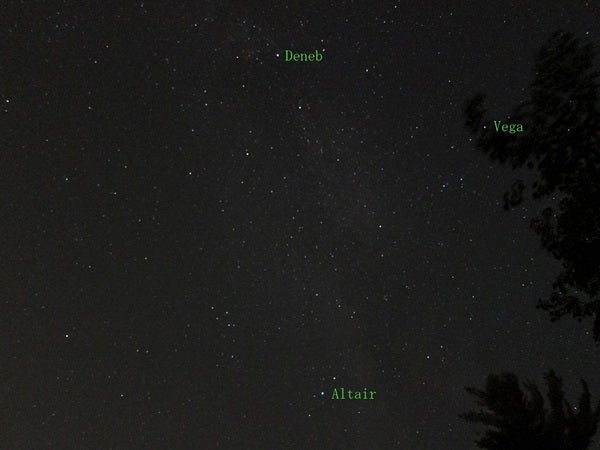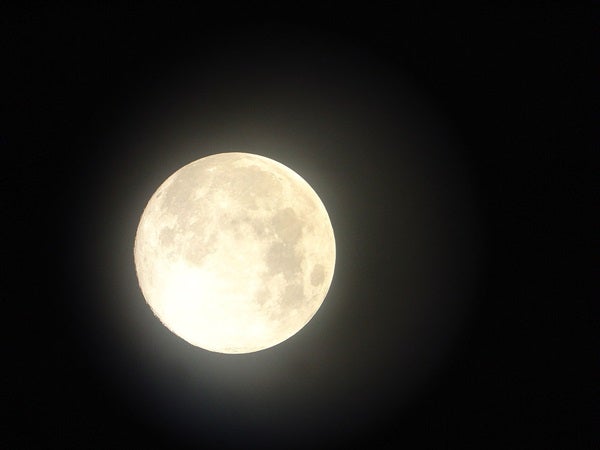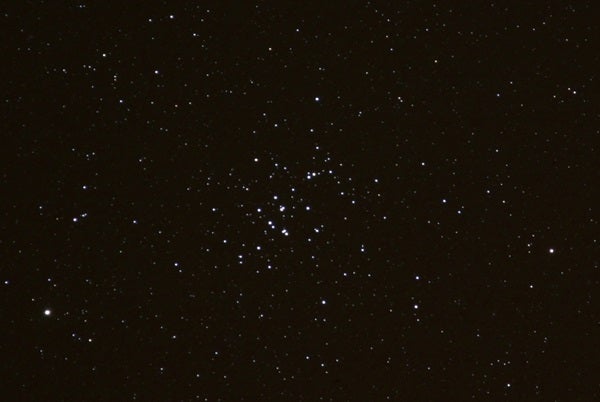Friday, May 5
Although the calendar says May, the sky’s Summer Triangle returns to prominence this month. The asterism’s three bright stars — Vega in Lyra, Deneb in Cygnus, and Altair in Aquila — all clear the horizon by midnight local daylight time. An hour later, they rule the eastern sky. Vega shines brightest and appears at the apex of the triangular asterism. Look for Deneb to Vega’s lower left and Altair to the lower right of the other two. The Summer Triangle will grace the Northern Hemisphere’s evening sky from now through the end of the year.
Saturday, May 6
The Eta Aquariid meteor shower reaches its peak before dawn. Although this is typically one of the year’s most prolific showers, a waxing gibbous Moon interferes with the 2017 show. The Moon sets around 4 a.m. local daylight time, just before morning twilight starts to paint the sky. For the best views, head outside an hour or two before then and find a spot where trees or buildings block the Moon’s glow low in the west. Eta Aquariid meteors derive from bits of debris ejected by Comet 1P/Halley during its many trips around the Sun. When Earth crosses this debris stream, our planet’s atmosphere incinerates the tiny dust particles and we see the streaks of light called meteors, or “shooting stars.”
Sunday, May 7
Although Jupiter reached opposition and peak visibility exactly one month ago, it remains a stunning sight nearly all night. It appears about 40° above the southeastern horizon an hour after sunset and climbs highest in the south around 11 p.m. local daylight time. As a bonus this evening, a waxing gibbous Moon appears just a few degrees away. The pair lies among the background stars of Virgo, though only 1st-magnitude Spica some 10° below appears conspicuous thanks to the bright Moon nearby. When viewed through a telescope, Jupiter’s disk spans 43″ and shows a wealth of detail in its atmosphere.
Mars continues to put on a nice show in late April. It appears 10° high in the west-northwest an hour after sunset and doesn’t dip below the horizon until 10 p.m. local daylight time. The magnitude 1.6 Red Planet appears against the backdrop of Taurus the Bull and passes 6° due north (to the upper right) of Aldebaran today. Use binoculars to pick them out of the evening twilight. Although Aldebaran shines a half-magnitude brighter than the planet, Mars’ greater altitude should make it just as easy to see.
Monday, May 8
The sky’s brightest asteroid should be relatively easy to find through binoculars or a telescope this evening. Eighth-magnitude Vesta resides in the constellation Cancer the Crab, where it slides just north of the 6th-magnitude star Lambda (l) Cancri. At closest approach, only 0.21° — less than half the diameter of a Full Moon — separates the two. To confirm a sighting, sketch four or five stars in the field of view and then return to the same field a night or two later. Vesta will be the “star” that moved.
Tuesday, May 9
Jupiter’s moons typically line up with the giant planet’s equator. But because the satellites’ orbital plane currently tilts 3° to our line of sight, they can sometimes appear oddly skewed. Tonight affords a perfect example. Io, Ganymede, and Callisto appear in a straight line that angles some 40° to Jupiter’s equator. The closest alignment occurs between roughly 1:00 and 1:30 a.m. on the 10th.
Wednesday, May 10
Full Moon occurs at 5:42 p.m. EDT, and our satellite looks completely illuminated all night. You can find it low in the southeast as darkness falls and peaking in the south around 1 a.m. local daylight time. The Moon lies among the background stars of Libra the Scales.
Thursday, May 11
Venus appears brilliant in the eastern sky from the time it rises around 4 a.m. local daylight time until close to sunrise nearly two hours later. It stands some 10° above the horizon an hour before the Sun comes up. Shining at magnitude –4.7, it easily ranks as the night sky’s brightest light after the Moon. When viewed through a telescope this morning, Venus spans 32″ and appears one-third lit.
Friday, May 12
One of the spring sky’s finest deep-sky objects, the Beehive star cluster (M44) in the constellation Cancer the Crab, lies high in the western sky after darkness falls. Under a dark sky before the Moon rises (around 10 p.m. local daylight time this evening and nearly an hour later with each passing night), you should be able to spot this star group with your naked eye as a faint and fuzzy cloud. But the Beehive explodes into dozens of stars through binoculars or a small telescope at low power.
The Moon reaches apogee, the farthest point in its orbit around Earth, at 3:51 p.m. EDT. It then lies 252,407 miles (406,210 kilometers) from Earth’s center.
Saturday, May 13
Saturn offers a visual treat all this week. The ringed planet shines at magnitude 0.2 against the background stars of western Sagittarius, rising by 11 p.m. local daylight time and climbing some 30° above the southern horizon around 3 a.m. Tonight finds it in the company of the waning gibbous Moon, which appears some 3° to the planet’s left as the pair rises. When viewed through a telescope this week, Saturn shows an 18″-diameter disk surrounded by a spectacular ring system that spans 41″ and tilts 26° to our line of sight.
Sunday, May 14
Neptune rises around 3 a.m. local daylight time and appears low in the east-southeast before dawn. The distant world glows at magnitude 7.9, so you’ll need binoculars or a telescope to spot it. Fortunately, it lies near a brighter star that will guide you to the planet. This morning, Neptune passes 9′ due south of 6th-magnitude 81 Aquarii. The star shines some five times brighter than the planet. You can confirm your sighting of Neptune through a telescope, which reveals the planet’s 2.3″-diameter disk and blue-gray color.












